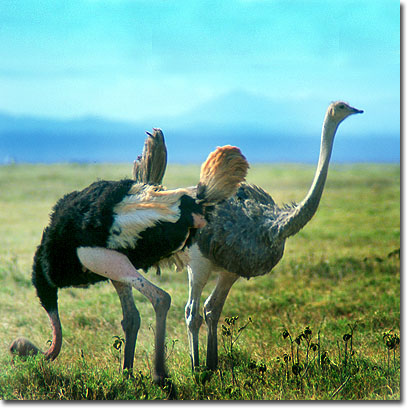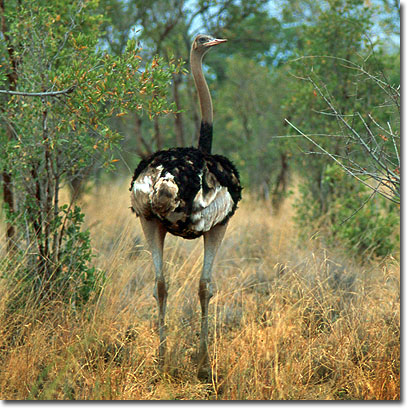
Common ostrich
'Struthio camelus massaicus'
Other names: Masai ostrich
Swahili: Mbuni
Best parks to see it: Amboseli, Masai Mara, Nairobi, Tsavo
Unmistakable dweller of the plains, where it can be found solitary or in groups. Inhabits the southern parks, from Tsavo to Masai Mara. Less abundant in Laikipia, Baringo and Maralal. The common ostrich is different from the Somali in the pink colour of its neck, flanks and legs, becoming brighter in the breeding season, though it can be partially concealed by the dust. The male's plumage is very flashy, whereas the female is duller, grey-brown in colour.
Male and female common ostriches in Amboseli National Park. J.Y./Kenyalogy.com

Somali ostrich
'Struthio (camelus) molybdophanes'
Swahili: Mbuni
Best parks to see it: Samburu, Meru
Unlike the common ostrich, the Somali does not like the open plains, being more usual to find it in bush and scrubland, solitary or in pairs. Inhabits northern Kenya from lake Turkana to Wajir, and southward to Samburu, Meru and Tsavo East. The Somali ostrich can be distinguished from the common by the blue tone in neck, flanks and legs, which becomes brighter in the breeding season, though it can be partially concealed by the dust. The male's plumage is very flashy, whereas the female is duller, but browner and less grey than the common ostrich's female. The most recent studies suggest that the Somali ostrich forms a separate species.
Somali ostrich in Meru National Park. J.Y./Kenyalogy.com
|



